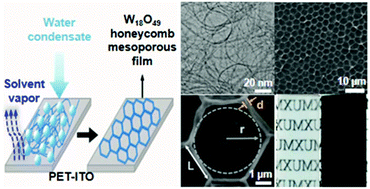Ultra-large optical modulation of a size-tunable flexible electrochromic honeycomb mesoporous tungsten oxide film†
Abstract
Stimulus-driven color-change films are a basic optical component for the fabrication of a stimulus-driven color-change optical device. The practical application of this device is greatly affected by the performance of the stimulus-driven color-change film. Herein, we present the W18O49 honeycomb mesoporous pattern (HMP) film with excellent electrochromic performance. The W18O49 HMP film is prepared on a flexible substrate (indium tin oxide-coated polyethylene terephthalate polyester film, ITO-PET) by integrating the polymer-like ultrathin W18O49 nanowires (NWs) through the classical static breath figure method. By altering the concentration of the W18O49 NW dispersion, the pore size of the obtained W18O49 HMP film can be facilely tuned; this results in tunable optical modulation. The obtained W18O49 HMP film exhibits improved electrochromic properties with an optimized optical modulation of 73%, fast switching time, high coloration efficiency, and high stability even under deformation. The presented method for the fabrication of size-tunable flexible electrochromic films from ultrathin polymer-like NWs can be further extended to the fabrication of various NW-based flexible devices in the future.



 Please wait while we load your content...
Please wait while we load your content...